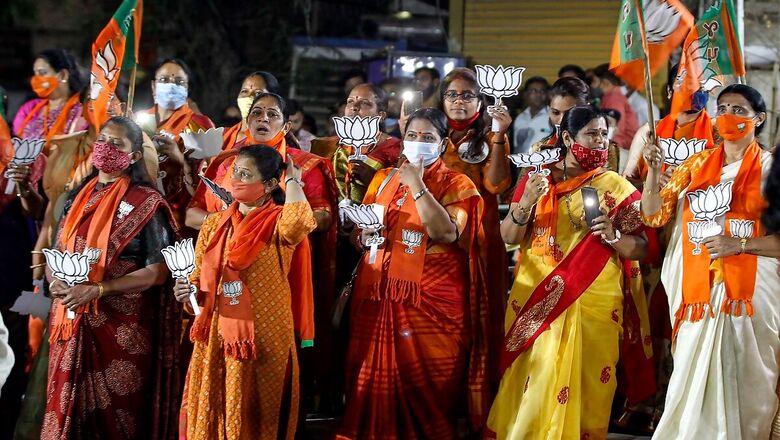
views
Considering the last time people of Gujarat voted for the Congress in a Lok Sabha or Vidhan Sabha election was in 1985, 2015 had many positive undertones for the party. Just a year ago in 2014, Narendra Modi had shifted to the Centre leaving a huge vacuum in the state politics. In July-August 2015, the Patidar agitation drew a wedge between the BJP and its most solid support bloc. In such a context, the Congress swept rural Gujarat and reduced the BJP’s margins in urban Gujarat. Rajkot, the city where the BJP first tasted victory in the 1980s, almost gave a tie between the BJP and Congress. In taluka panchayats, the Congress won 134 seats, while the BJP bagged 67. In district panchayats, the Congress flag flew over 24 district headquarters, restricting the BJP to only six HQs.
Then came the 2017 Gujarat Assembly elections in which the Congress won 77 seats, with a large chunk of seats coming from rural areas. The gains in the 2015 local polls extended to the 2017 Assembly polls.
But, any hope for a prolonged comeback of Congress stand shattered after the 2021 local body polls across urban and rural Gujarat.
The results in urban Gujarat were broadly on expected lines but the margins were more than what the BJP had asked for. The party’s dominance was near total in Rajkot, Ahmedabad, Bhavnagar, Vadodara and Jamnagar. In Surat, the party reversed its losses and made spectacular gains. The BJP has won 10 times the number of seats grabbed by the Congress.
But, it is the rural local body polls that deserve careful attention. The Congress is wiped out in all district panchayats and the performance is dismal in taluka panchayats too.
Through the mandate, the people of Gujarat have conveyed multiple messages. The first and foremost message being Gujarat stands with Narendra Modi like a giant rock. The support for the Prime Minister is only increasing. Not only that, it will punish any negative campaign against Modi. Take for example, the constant rants of Rahul Gandhi against the Prime Minister. Such rants will never work in Gujarat.
But another important message that comes out is that the Congress has failed as a party of governance in the eyes of Gujarat. The wins in 2015 and 2017 gave the Congress enough room to groom an alternative leadership as well as a development model that would differentiate them from the BJP.
Instead of focusing on grassroots-level issues, the Congress preferred negative campaigning against PM Modi personally and the BJP. When a party has no stakes, it is fine, but when it had the opportunity to work, such grandstanding was not appreciated by the people. Congress MLAs were not even accessible in their areas. No wonder that in districts like Amreli where the BJP blanked out in 2015 and 2017, it has again made inroads. Amreli is a largely rural and Patidar-dominated district.
Gujarat has shown that political rhetoric during campaigns must be backed by ground-level work in non-campaign times. The jolt of 2015 was enough to wake the BJP up and it overhauled its working style. Its urban leaders began to be seen more actively on the ground, while the rural leadership went village to village highlighting the party’s development plank. The shrill anti-Gujarat trader tirade of Rahul Gandhi in Assam is supposed to have angered many in the state, where enterprise is respected widely.
There is also a message on how Gujarat views the farm laws, since rural Gujarat consists of many small farmers in particular. Inspired by the legacy of one of India’s tallest farmer leaders, Sardar Patel, Gujarati farmers have always been progressive and willing to embrace new technologies in farming. Gujarat was one of the first states to embrace the cooperative sector too. When Modi was the CM, drought-prone districts like Kutch and Banaskantha achieved agriculture turnarounds. It was due to the then CM’s efforts that farmers in Gujarat tasted much success in contract farming, started getting better market places, got easier access to irrigation and more. Hence, the shrill anti-farm laws campaign could not work in Gujarat.
In trying to portray Modi as a one-man show, his supporters and critics do not see what I feel has been his most underrated traits- a stellar organisation builder. The fact that after seven years of his departure to central politics, the BJP dominating Gujarat’s political landscape is a testimony to the organisational strength achieved during under his mentorship.
We saw how the Congress collapsed in Tamil Nadu after Kamraj, in Andhra Pradesh after YSR and in Maharashtra after Vilasrao Deshmukh. In contrast, the BJP scales newer heights in Gujarat. This is a living testimony to Modi’s organisational genius. Let me give you one example — conventional political wisdom means important appointments are made on the basis of caste considerations. Modi changed that by making CR Patil the state unit president. He does not belong to any dominant caste. Yet the energy he has instilled in the cadre is huge. This has certainly contributed to the big win.
There are important messages from Gujarat which our political class should study carefully and absorb the learnings.
Read all the Latest News, Breaking News and Coronavirus News here
















Comments
0 comment